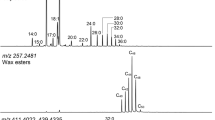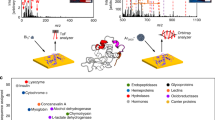Abstract
Our skin, our belongings, the world surrounding us, and the environment we live in are covered with molecular traces. Detecting and characterizing these molecular traces is necessary to understand the environmental impact on human health and disease, and to decipher complex molecular interactions between humans and other species, particularly microbiota. We recently introduced 3D molecular cartography for mapping small organic molecules (including metabolites, lipids, and environmental molecules) found on various surfaces, including the human body. Here, we provide a protocol and open-source software for 3D molecular cartography. The protocol includes step-by-step procedures for sample collection and processing, liquid chromatography–mass spectrometry (LC–MS)-based metabolomics, quality control (QC), molecular identification using MS/MS, data processing, and visualization with 3D models of the sampled environment. The LC–MS method was optimized for a broad range of small organic molecules. We enable scientists to reproduce our previously obtained results, and illustrate the broad utility of our approach with molecular maps of a rosemary plant and an ATM keypad after a PIN code was entered. To promote reproducibility, we introduce cartographical snapshots: files that describe a particular map and visualization settings, and that can be shared and loaded to reproduce the visualization. The protocol enables molecular cartography to be performed in any mass spectrometry laboratory and, in principle, for any spatially mapped data. We anticipate applications, in particular, in medicine, ecology, agriculture, biotechnology, and forensics. The protocol takes 78 h for a molecular map of 100 spots, excluding the reagent setup.
This is a preview of subscription content, access via your institution
Access options
Access Nature and 54 other Nature Portfolio journals
Get Nature+, our best-value online-access subscription
$29.99 / 30 days
cancel any time
Subscribe to this journal
Receive 12 print issues and online access
$259.00 per year
only $21.58 per issue
Buy this article
- Purchase on Springer Link
- Instant access to full article PDF
Prices may be subject to local taxes which are calculated during checkout


Similar content being viewed by others
References
Petras, D., Jarmusch, A.K. & Dorrestein, P.C. From single cells to our planet—recent advances in using mass spectrometry for spatially resolved metabolomics. Curr. Opin. Chem. Biol. 36, 24–31 (2017).
Bouslimani, A. et al. Molecular cartography of the human skin surface in 3D. Proc. Natl. Acad. Sci. USA 112, E2120–E2129 (2015).
Bouslimani, A. et al. Lifestyle chemistries from phones for individual profiling. Proc. Natl. Acad. Sci. USA 113, E7645–E7654 (2016).
Petras, D. et al. Mass spectrometry-based visualization of molecules associated with human habitats. Anal. Chem. 88, 10775–10784 (2016).
Human Microbiome Project Consortium. Structure, function and diversity of the healthy human microbiome. Nature 486, 207–214 (2012).
Berthold, M.R. et al. in Data Analysis, Machine Learning and Applications (eds. Preisach, C. et al.) 319–326 (Springer, 2008).
Sturm, M. et al. OpenMS - an open-source software framework for mass spectrometry. BMC Bioinformatics 9, 163 (2008).
Kenar, E. et al. Automated label-free quantification of metabolites from liquid chromatography-mass spectrometry data. Mol. Cell. Proteomics 13, 348–359 (2014).
Pukui, M.K. & Elbert, S.H. Hawaiian Dictionary: Hawaiian-English, English-Hawaiian (University of Hawaii Press, 1986).
Baker, M. 1,500 Scientists lift the lid on reproducibility. Nature 533, 452–454 (2016).
Aksenov, A.A., da Silva, R., Knight, R., Lopes, N.P. & Dorrestein, P.C. Global chemical analysis of biology by mass spectrometry. Nat. Rev. Chem. 1, 0054 (2017).
Sumner, L.W. et al. Proposed minimum reporting standards for chemical analysis Chemical Analysis Working Group (CAWG) Metabolomics Standards Initiative (MSI). Metabolomics 3, 211–221 (2007).
Vuckovic, D. Current trends and challenges in sample preparation for global metabolomics using liquid chromatography-mass spectrometry. Anal. Bioanal. Chem. 403, 1523–1548 (2012).
Wehrens, R. et al. Improved batch correction in untargeted MS-based metabolomics. Metabolomics 12, 88 (2016).
Koal, T. & Deigner, H.-P. Challenges in mass spectrometry based targeted metabolomics. Curr. Mol. Med. 10, 216–226 (2010).
Bylda, C., Thiele, R., Kobold, U. & Volmer, D.A. Recent advances in sample preparation techniques to overcome difficulties encountered during quantitative analysis of small molecules from biofluids using LC-MS/MS. Analyst 139, 2265–2276 (2014).
Dührkop, K., Shen, H., Meusel, M., Rousu, J. & Böcker, S. Searching molecular structure databases with tandem mass spectra usingCSI:FingerID. Proc. Natl. Acad. Sci. USA 112, 12580–12585 (2015).
Tsugawa, H. et al. Hydrogen rearrangement rules: computational MS/MS fragmentation and structure elucidation using MS-FINDER software. Anal. Chem. 88, 7946–7958 (2016).
Wang, M. et al. Sharing and community curation of mass spectrometry data with global natural products social molecular networking. Nat. Biotechnol. 34, 828–837 (2016).
Kessner, D., Chambers, M., Burke, R., Agus, D. & Mallick, P. ProteoWizard: open source software for rapid proteomics tools development. Bioinformatics 24, 2534–2536 (2008).
Böcker, S. & Dührkop, K. Fragmentation trees reloaded. J. Cheminform. 8, 5 (2016).
Chambers, M.C. et al. A cross-platform toolkit for mass spectrometry and proteomics. Nat. Biotechnol. 30, 918–920 (2012).
Cignoni, P. et al. Meshlab: an open-source mesh processing tool. Eurographics Italian Chapter Conference 2008, 129–136 (2008).
Luis, J.C., Pérez, R.M. & González, F.V. UV-B radiation effects on foliar concentrations of rosmarinic and carnosic acids in rosemary plants. Food Chem. 101, 1211–1215 (2007).
Petersen, M. Rosmarinic acid: new aspects. Phytochem. Rev. 12, 207–227 (2013).
Munné-Bosch, S., Schwarz, K. & Alegre, L. Enhanced formation of α-tocopherol and highly oxidized abietane diterpenes in water-stressed rosemary plants. Plant Physiol. 121, 1047–1052 (1999).
de Fine Olivarius, F. UV-radiation and urocanic acid, In: Skin Cancer and UV Radiation (eds Altmeyer P., Hoffmann K. & Stücker M.) 131–136 (Springer, 1997).
Acknowledgements
This project received funding from the European Union's Horizon 2020 Research and Innovation Programme under grant agreement no. 634402 (to T.A. and I.P.), from Marie Skłodowska-Curie Action grants MSCA-IF-2016, 3D-Plant2Cells, and ID 704786 (to L.-F.N.), from US National Institutes of Health (NIH) grant 5P41GM103484-07, from National Institute of Justice Award 2015-DN-BX-K047 (to A.B.), and from NIH grant GMS10RR029121. P.C.D. further thanks the Alfred P. Sloan Foundation program on the Microbiology of the Built Environment for its support. We thank the EMBL Metabolomics Core Facility for LC–MS experiments, and Bruker Daltonics for the shared instrumentation infrastructure that enabled this work. We thank M. Rurik (OpenMS development team) and A. Fillbrunn from the KNIME development team for their advice, and V. Kovalev (EMBL) for helping with data analysis. We thank C. Kapono and D. Petras (UCSD) for helpful discussions.
Author information
Authors and Affiliations
Contributions
I.P. and S.R. developed the software. T.A. created prototype software and coordinated computational research and software development. I.P., A.V.M., L.-F.N., L.R., and A.B. analyzed the data. A.V.M., L.-F.N., A.A.A., and P.P. performed mass spectrometry experiments. L.-F.N. and A.A.A. contributed to the rosemary study. I.P., L.R., P.P., and T.A. contributed to the ATM keypad study. I.P., A.V.M., L.-F.N., P.C.D., and T.A. wrote the manuscript; all authors contributed to the writing. P.C.D. and T.A. coordinated the research, development, and experiments.
Corresponding authors
Ethics declarations
Competing interests
The authors declare no competing financial interests.
Integrated supplementary information
Supplementary Figure 1 Results for the lifestyle chemistries from phones study.
Visualization of nystatin and unannotated metabolites across samples from the published study on lifestyle chemistries from phones3. The set of samples represent one 96-well plate from the study, containing blank samples, row A, and samples from 7 volunteers, rows B-H. See cartographical snapshots in Supplementary Data 7.1-7.4.
Supplementary Figure 2 Examples of molecular maps of unannotated molecules in tissues of Rosmarinus officinalis plant with predominant occurrence in the flowers.
These examples were chosen to highlight compounds that change in abundance in different parts of the plant as they mature. These results may lead to discovery of novel natural products. See cartographical snapshots in Supplementary Data 7.5-7.7.
Supplementary Figure 3 Examples of molecular maps of unannotated molecules in tissues of Rosmarinus officinalis plant with predominant occurrence the foliage.
See cartographical snapshots in Supplementary Data 7.8-7.10.
Supplementary information
Supplementary Text and Figures
Supplementary Figures 1–5, Supplementary Table 1, and Supplementary Methods. (PDF 1434 kb)
Supplementary Data 1
Example Optimus input files. (ZIP 97 kb)
Supplementary Data 2
Human built environment. (ZIP 21036 kb)
Supplementary Data 3
Human skin. (ZIP 4919 kb)
Supplementary Data 4
Lifestyle chemistries from phones. (ZIP 2093 kb)
Supplementary Data 5
Rosemary plant. (ZIP 826 kb)
Supplementary Data 6
ATM keypad. (ZIP 33040 kb)
Supplementary Data 7
URL links to cartographical snapshots for the considered studies. (PDF 118 kb)
Rights and permissions
About this article
Cite this article
Protsyuk, I., Melnik, A., Nothias, LF. et al. 3D molecular cartography using LC–MS facilitated by Optimus and 'ili software. Nat Protoc 13, 134–154 (2018). https://doi.org/10.1038/nprot.2017.122
Published:
Issue Date:
DOI: https://doi.org/10.1038/nprot.2017.122
This article is cited by
-
Visualization of metabolites and microbes at high spatial resolution using MALDI mass spectrometry imaging and in situ fluorescence labeling
Nature Protocols (2023)
-
Localized cardiac small molecule trajectories and persistent chemical sequelae in experimental Chagas disease
Nature Communications (2023)
-
Evaluating LC-HRMS metabolomics data processing software using FAIR principles for research software
Metabolomics (2023)
-
Mass spectrometry-based metabolomics in microbiome investigations
Nature Reviews Microbiology (2022)
-
Contribution of the Gut Microbiome to Drug Disposition, Pharmacokinetic and Pharmacodynamic Variability
Clinical Pharmacokinetics (2021)
Comments
By submitting a comment you agree to abide by our Terms and Community Guidelines. If you find something abusive or that does not comply with our terms or guidelines please flag it as inappropriate.



